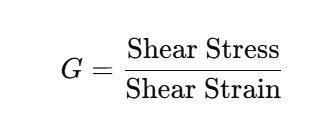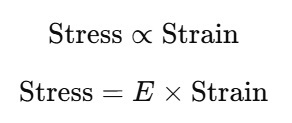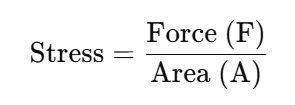Physics Spl
Get insights from 7.5k questions on Physics Spl, answered by students, alumni, and experts. You may also ask and answer any question you like about Physics Spl
Follow Ask QuestionQuestions
Discussions
Active Users
Followers
New answer posted
7 months agoContributor-Level 10
The modulus of elasticity refers to the material's capacity to withstand or resist deformation when stress is applied. There are three types of the modulus of elasticity including:
Young's Modulus (E): It is used to measure a solid's elasticity when longitudinal stress (tensile or compressive) is applied to it. Mathematically, it is represented by the following formula;
SI Unit is N/m² (Pascal, Pa).
Bulk Modulus (K): It is used to measure the ability of the material to resist volume change when uniform pressure is applied to it. Mathematically, it is:
Shear Modulus (G) or Modulus of Rigidity: It is used when a shear
New answer posted
7 months agoBeginner-Level 5
Candidates must check their target university's subject mapping criteria to decide which subject to map with CUET Physics. However, the common CUET subject combinations for CUET Physics include:
- Mathematics
- Chemistry
- Biology
- Computer Science
- Environmental Science
New answer posted
7 months agoBeginner-Level 5
The difficulty level for CUET Physics exam is uaully considered moderate to high. The question paper my include questions that require candidates to use their analytical thinking skills. Additionally, calculation-based questions might be time consuming making it hard for candidates to complete their exam on time.
New answer posted
7 months agoBeginner-Level 5
The CUET Physics Paper consists of 50 questions and the candidates are required to attempt all questions within 60 minute time frame. Each correct answer carries 5 marks, and 1 mark is deducted for incorrect responses. Candidates taking the exam must ensure to manage their time effectively.
New answer posted
7 months agoContributor-Level 10
The chapter consists of fundamental topics that are important for board exams preparation as well as for competitive tests:
Composition and Size of the Nucleus: Understanding protons, neutrons, and nuclear density.
Nuclear Force: The forces that hold the nucleus together.
Mass-Energy Equivalence (E = mc²): Einstein's equation and its significance in nuclear reactions.
Nuclear Binding Energy: Understanding nuclear stability and energy release.
Radioactivity: Concepts of alpha, beta, and gamma decay.
Laws of Radioactive Decay: Half-life, mean life, and decay constant derivations.
Nuclear Fission and Fusion: Their
New answer posted
7 months agoContributor-Level 10
Hooke's Law states that within the elastic limit, the stress applied to a material is directly proportional to the strain produced. Mathematically,
E stands for the modulus of elasticity also called Young's modulus in case of linear deformation.
The Hooke's Law defines the elastic behaviour of materials, determines its elastic limit and helps in material selection for construction and manufacturing. It is used to design springs and elastic components in machines. Hook's law is applicable for the solids within their elastic limit.
Hooke's law for a spring and other elastic material is shown as:
F is the force applied on the mat
New answer posted
7 months agoContributor-Level 10
Students can download the Class 12 Physics Chapter 13 Nuclei NCERT Solutions PDF from various online platforms or they can visit the Shiksha homepage.
These PDFs are useful for students who want to study anywhere even if there is no internet access, which makes it easier to practice important numerical problems related to decay laws, nuclear binding energy, and nuclear reactions. To get access to NCERT Solutions PDF Class 12 Physics Chapter 13 Nuclei students mucst click on the following link.
New answer posted
7 months agoContributor-Level 10
NCERT Solutions for Class 12 Physics Chapter 13 Nuclei is a detailed explanation of all the important concepts, solved numerical problems, and step-by-step derivations, that can be asked in competitve exams JEE, NEET, and other entrance exmas. There are various competitive exams that consists of questions on half-life, nuclear reactions, radioactive decay, and mass-energy equivalence, all of which are thoroughly included in NCERT solutions PDFs.
New answer posted
7 months agoContributor-Level 10
While studying the mechanical properties of solids, stress and strain are fundamental concepts.
Stress: It refers to the condition when the external force is applied to a solid body and it experiences an internal restoring force per unit area. The resisting deformation due to the internal force is called stress. The formula is:
The SI unit of stress is N/m² (Pascal, Pa).
There are three types of stress -
- When the applied force increases the length of the body, it is called tensile stress.
- When the applied force decreases the length of the body, it is termed as the compressive stress.
- When the force is applied tangentially and creates defor
Taking an Exam? Selecting a College?
Get authentic answers from experts, students and alumni that you won't find anywhere else
Sign Up on ShikshaOn Shiksha, get access to
- 65k Colleges
- 1.2k Exams
- 679k Reviews
- 1800k Answers







